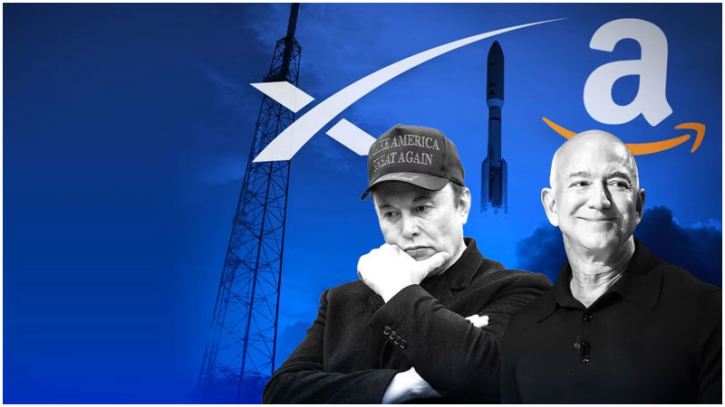Has Starlink already won the new space race?

After years of effort and some frustrating delays, Amazon’s dream of delivering high-speed internet to some of the remotest places on Earth quite literally got off the ground last month.
On a warm evening in April, United Launch Alliance’s Atlas V rocket roared away from its launch pad at Florida’s Cape Canaveral, carrying the first operational satellites for Project Kuiper, the tech giant’s new broadband network.
Within minutes, the rocket had hit more than 6,400km an hour, dropping Kuiper’s 27 satellites 450km above the Earth, from where they will climb to their final orbit at 630km.
The successful deployment marked more than the birth of a new internet service provider. It was the opening shot in a battle over the future of global connectivity, one that pits Amazon founder Jeff Bezos against fellow billionaire Elon Musk, owner of the world’s largest satellite broadband network Starlink, a subsidiary of parent company SpaceX.
But the two tech titans also face competition from global powers such as China and the EU in a race to control the space-based infrastructure that will influence economic, military and digital power. It is a rivalry that has the potential to determine future digital divides — some countries under western systems, others under tightly controlled Chinese networks.
“We are in the midst of a global space race that will have very significant consequences in terms of economic opportunity, connectivity . . . and national security,” says Brendan Carr, chair of the US regulatory agency, the Federal Communications Commission (FCC).
The jostling is taking place in low Earth orbit (LEO), one of the most contested regions of space, located up to 2,000km above the Earth.
Ten years ago, this was the preserve of Earth observation, science and military satellites, and satellite phone providers, with around 1,300 active spacecraft in orbit. Today, thanks to SpaceX’s reusable Falcon rockets, there are more than 11,000 active satellites, supporting everything from weather tracking to broadband.
Experts forecast that the number of satellites in LEO will balloon to as many as 100,000 over the next decade as companies, governments and militaries rush to exploit the potential of the new space frontier.
But it is the world’s voracious appetite for connectivity that is driving the boom in the LEO market.
Being nearer to Earth, LEO systems offer lower latency — the time it takes for a signal to travel from Earth to satellite and back again — than geostationary satellites, traditionally used for broadcasting, which orbit much higher at altitudes of about 36,000km.
Project Kuiper is just one of many contenders vying for a share of this expanding business. The top eight players have permission for more than 50,000 satellites; Starlink alone is approved for 12,000, according to space consultancy Analysys Mason.
Others include Eutelsat’s OneWeb, the world’s second biggest operational LEO network, which is seeking to serve the government and enterprise markets with its 648-strong constellation, or cluster of satellites.
Canada’s Telesat is developing Lightspeed, which will have about 200 spacecraft also focused on higher-margin government and enterprise markets. Others are proposing constellations dedicated to connecting mobile phones in regions where cell towers cannot reach.
And at least two Chinese systems under development — Guowang and SpaceSail — are proposing to fly some 26,000 satellites combined.
But all these constellations will have to reckon with Musk’s Starlink, by far the dominant force.
Since 2019, Musk has launched more than 8,417 satellites — 39 per cent of all those launched since Sputnik, the first artificial satellite to be sent into orbit. Starlink has about 7,300 operational satellites circling the Earth, representing almost two-thirds of all operational spacecraft, according to Jonathan McDowell, astrophysicist and space flight historian.
Starlink’s success stems from SpaceX’s unique in-house capabilities: low-cost and frequent Falcon 9 launches; a manufacturing facility producing more than eight satellites daily, according to consultancy Quilty Space; a rapid innovation culture; and abundant financing from its billionaire owner.
The project has also prioritised usability and affordability, targeting the high-volume consumer market with small but highly complex antennas, or terminals, priced at a few hundred dollars.
These flat, notebook-sized antennas are able to automatically align with the satellites speeding across the sky. They were initially estimated to cost about $2,000 to make and SpaceX had to subsidise them to keep prices affordable. But the rapid pace of iteration and expansion, with roughly two launches a week, has created the volumes needed to bring down the cost and subsidy.
“Starlink has more flexibility because it can add bells and whistles to its initial constellation with relatively minor adjustments,” says Patricia Cooper, founder of Constellation Advisory and a former vice-president in charge of regulatory affairs at SpaceX. “They have both the production line and the launch machine. That is their superpower.”
The result of Starlink’s speed and innovation is a system that even competitors struggle to fault.
“It is a good network and it’s going to get better over time,” says Telesat’s chief executive, Dan Goldberg.
Today it is delivering low-latency broadband to more than 5mn customers in 125 countries and is expected to generate $12bn in revenue and $2bn in free cash flow this year, according to Quilty. Ultimately, it aims to fly more than 40,000 satellites.
With such a lead, the challenge for competitors is enormous. For a start, LEO constellations are expensive. Amazon will need to spend between $16bn and $20bn to build Kuiper, Quilty estimates.
Satellites must also be replaced every five to seven years, adding costs. Eutelsat faces a €2bn bill to upgrade OneWeb, and may have to rely on its French state shareholder to provide the funds. Telesat has only been able to afford the Lightspeed investment thanks to a Canadian government loan of C$2.14bn ($1.54bn).
Financing is unlikely to be a problem for the Chinese constellations. SpaceSail, for example, is heavily supported by the Shanghai municipality and the Chinese Academy of Sciences, and raised almost $1bn in 2023. Guowang is owned by the national government’s China Satellite Networks, known as SatNet, with a mission to develop a Chinese Starlink. It was founded with capital of Rmb10bn ($1.4bn), according to think-tank Ifri.
Neither constellation is yet operational. But SpaceSail has launched 90 satellites and appears to be moving more quickly than Guowang. Although several of SpaceSail’s first satellites appear to have failed, the company intends to have hundreds flying by the end of the year.
For China, the biggest constraint appears to be getting satellites into orbit in the first place. “They have their satellite production lines running but . . . they need rockets that can launch more often, that can launch more satellites at a time and they really need the reusable first stages to make it more economic,” says McDowell, the astrophysicist.
Once launch bottlenecks ease — and rockets are being developed to do just that — China could scale fast, says Blaine Curcio of Orbital Gateway Consulting, an expert in Chinese satellite communications.
Curcio recently warned a US congressional commission that China has a deeper bench of start-ups and engineers advancing the latest satellite technology.
But not every constellation will be judged by its commercial success. Musk’s personality and controversial interventions in international politics are making some governments wary of his company’s dominance. So too is his proximity to the Trump administration, which appears bent on overturning long-standing alliances.
His refusal to grant Ukrainian forces access to Starlink satellites over Crimea has also been a red flag. “Sovereign access to space is becoming critical,” says Lluc Palerm Serra, research director at space consultancy Analysys Mason.
These concerns are prompting some governments to develop their own solutions.
“There is a technological wave that’s astonishing,” says Constellation’s Cooper, referring to the rise of LEO satellite constellations. “But it is also predominantly an American flex that is creating geopolitical ripples in Europe and China and other places.”
Last year, the EU committed €6bn to the €10bn IRIS² project, a sovereign multi-orbit broadband service aimed at governments and public institutions, expected to launch around 2030. But it will arrive five years later than Kuiper, and more than a decade after Starlink.
Taiwan, concerned by Musk’s ties to China, is planning its own LEO system. Germany and Italy are also exploring national constellations in addition to Iris².
Such systems will depend on government backing, which comes with its own difficulties. Critics of Iris² suggest the project is already overly complex, weighed down by national rivalries and European bureaucracy. The risk is not only that it will be late to the market, but that it may not be commercially competitive.
But in some regions sovereign capability is worth the price. “European countries are waking up to the fact that they need homegrown solutions to sovereign issues if they are not to be dependent on the US or China,” says Joanna Darlington, a Eutelsat executive committee member.
China in particular sees Starlink’s rapid expansion as a threat to both national and economic security.
“Before 2020, there were a couple of OneWeb-like constellations being developed, but there wasn’t a lot of urgency,” says Orbital’s Curcio. “But after Starlink accelerated its cadence from 2020 the Chinese government prioritised satellite internet as a needed infrastructure.”
The US think-tank Rand published a study this year that found both the Chinese Communist party and the People’s Liberation Army “consider Starlink to be a tool of military power”, giving added impetus to the government’s strategy. Starlink’s role in providing connectivity to Ukrainian forces fighting Russia’s invasion “validated [their] view”.
For China, as for the US, the ability to offer LEO connectivity is a useful tool for influence. According to Curcio, SpaceSail seems to be the vehicle for China’s so-called digital silk road — which adds connectivity to its flagship Belt and Road Initiative, a trillion-dollar infrastructure programme. Guowang, by contrast, is likely to be focused on the national market.
In recent months, SpaceSail has been striking deals in Belt and Road countries such as Malaysia, where domestic satellite operator MeaSat was one of Starlink’s first distribution partners.
MeaSat’s agreement demonstrates the advantage that Chinese constellations may have over Starlink. Its agreement with the Chinese company goes further than the Starlink partnership, covering joint marketing, research and development, collaboration on new markets and studies into cutting-edge frequencies that could in future be used to transmit even more data across Leo networks.
Such an approach will “play into China’s favour in some countries because they are playing a longer game”, Curcio says. Africa, in particular, could be open to such trades, suggest several industry insiders. In addition, Chinese providers could focus on offering lower prices in emerging markets where Starlink’s terminal may still represent a hefty outlay.
“Their goals are not necessarily designed for profit,” says Larry Wortzel, senior fellow in Asian security at the American Foreign Policy Council think-tank. “They are designed to create dependency networks for financing, standards and equipment in infrastructure.”
China’s strategy has alarmed many in the US. “The bogey down the road is combining the Belt and Road Initiative with a high-speed LEO satellite system,” says the FCC’s Carr. “That has very serious geopolitical implications. That is why it is imperative to knock down any barriers that will slow down western satellite technology.”
Less than six months into the job, Carr has already begun taking down some of those barriers by easing regulations.
On the day Kuiper launched, the agency announced it intended to loosen power limits on LEO transmissions over the US, which were designed to avoid interference with geostationary orbit satellites. Raising the caps will help all LEO operators boost speeds and handle more customers.
But the one most constrained by those limits is Starlink, says Tim Farrar, of consultancy TMF Associates. “Loosening the limits will enable Starlink to get even further ahead, and gain even more economies of scale.”
Most new entrants are not trying to match Starlink’s scale, however, and instead are targeting high-margin government or enterprise markets.
“I don’t think about it as catching up to them or eclipsing them,” says Telesat’s Goldberg. “They are far ahead of everyone else. But I still think there is room for others to be successful,” he adds, noting the recent deal with American communications company Viasat to supply Lightspeed connectivity to aviation customers.
One Eutelsat shareholder believes OneWeb could be successful selling only a fraction of Starlink’s capacity to customers seeking diversity. “People will still need a small sliver of capacity to have backup,” says the shareholder, who asked to remain anonymous. “There is a market for that — at a much higher price.”
However, Starlink and soon Kuiper are also targeting these enterprise and government markets, and will have cheaper terminals.
Kuiper has said it intends to offer a limited service this year, with the industry expecting global reach by 2029.
While little is known about its planned business model, one former Amazon executive told the Financial Times that the aim is to be “better in quality and lower in price than SpaceX”.
The company could also leverage Amazon Web Services, the world’s largest cloud computing and storage provider, to offer secure bundled storage and connectivity.
But Amazon’s biggest advantage could be its global retail network, say observers. “[Bezos] could send everybody with an Amazon Prime subscription a laptop that automatically connects to his satellites and overnight have 200mn retail subscribers,” says Ruth Pritchard-Kelly, principal at consultancy RPK Advisors and a former executive at OneWeb. “That’s [the] ace up his sleeve.”
Still, Kuiper faces challenges. Unlike SpaceX, which is privately owned, the publicly listed Amazon will have to show returns on its Kuiper investment.
Amazon has also struggled with production delays that have hampered Kuiper’s deployment, according to a person familiar with the matter. But the company insists it is on track and has booked more than 80 launches for Kuiper over five years.
Several of the launches are on new rockets, however, which still have to prove they can launch frequently and reliably.
These and other challenges have left Amazon behind its original schedule. It will almost certainly have to ask the FCC for an extension of the July 2026 deadline to launch half its satellites. Meanwhile, SpaceX is putting satellites into orbit every week.
Some in the industry believe that Starlink may have 18 months to two years before Amazon perfects its services. But once on the market, it will move quickly, industry observers say.
“Amazon knows how to make consumer products. It has a culture of customer service that SpaceX did not have,” says another former SpaceX employee.
Caleb Henry, Quilty’s director of research, believes Amazon will become a formidable competitor. “Amazon has the balance sheet and the technology,” he says. “Kuiper intends to make tens of millions of terminals. When you get the volumes, that is when you drive terminal prices down to affordable consumer rates. When you get to consumer rates, your market explodes.”
While a head-to-head battle between Amazon and Starlink may benefit consumers, it could strain the wider LEO satellite communications industry, warns TMF’s Farrar.
“There will be a price war,” Farrar says. “Elon Musk has never really been concerned with economic returns. If you have one economically rational player in Amazon, competing with an economically irrational player in Starlink, then you know what’s going to happen. People go bankrupt.”
.png)




